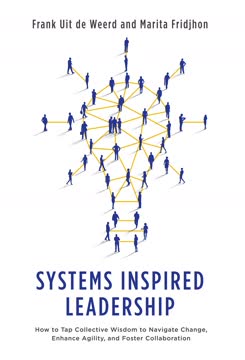Key Takeaways
1. Embrace Systems Inspired Leadership (SIL) for a Complex World
Systems Inspired Leadership provides a powerful alternative.
Shift from heroic leadership. The traditional "heroic" or "the-leader-knows-all" paradigm of leadership, prevalent in the 20th century, is increasingly obsolete in today's volatile, uncertain, complex, and ambiguous (VUCA) world. This outdated model often leads to immense pressure, stress, and isolation for leaders, as well as disengagement within organizations. Systems Inspired Leadership (SIL) offers a transformative approach, moving beyond top-down directives to leverage the collective intelligence and creativity of the entire system.
Leadership as a system's role. SIL redefines leadership not as an individual's sole burden, but as a role belonging to the entire system, inviting all employees to step into their leadership capacity. This shift reduces individual stress and enhances overall effectiveness by tapping into the wisdom of the collective. It encourages leaders to facilitate what is trying to happen within a system, rather than imposing solutions, fostering agility and innovation.
Focus on relationships. At its core, SIL emphasizes the web of relationships within an organization, acknowledging that everything is interconnected and interdependent. Problems often reside in the dynamics between parts, not just in individual components. By focusing on building conscious and intentional relationships, SIL helps organizations navigate change, enhance agility, and foster collaboration, leading to sustainable results and a deeper sense of meaning and belonging for all involved.
2. Understand Relationship Systems Intelligence (RSI) and its Principles
At the core of Systems Inspired Leadership is Relationship Systems Intelligence (RSI).
Beyond individual intelligence. Relationship Systems Intelligence (RSI) is the foundational intelligence for Systems Inspired Leadership, transcending Emotional Intelligence (EQ) and Social Intelligence (SI). RSI is the ability to interpret individual experiences as expressions of the larger system, focusing on the relationship system itself rather than just its individual members. This allows leaders to create from the system's inherent wisdom and facilitate its growth and evolution.
Five core principles of RSI:
- Unique Identity: Each relationship system (e.g., team, department) has its own distinct "personality" or "3rd entity," separate from its individual members.
- Voice of the System: Every member's experience is both personal and an expression of the whole system, holding valuable wisdom, including marginalized voices.
- Natural Intelligence: Relationship systems are inherently intelligent, generative, and creative, capable of self-correction and emergence when revealed to themselves.
- Roles Belong to the System: Roles (both outer like CEO and inner like "disturber") are functions of the system, not fixed to individuals, allowing for fluidity and shared leadership.
- Constant Emergence: Systems are always evolving, with change being a natural state, and conflict serving as an engine for new possibilities.
The Systems Inspired Rule. A guiding tenet of RSI is "everybody is right… partially." This rule encourages openness to influence, refraining from judgment, and genuine curiosity, especially towards disruptive or complaining voices. Adopting this mindset helps make stuck systems more fluid, enhances agility, and uncovers new information about what is trying to emerge.
3. See, Hear, and Sense the System for Deeper Insight
Ability to focus on the system as a whole and apply the principles of Relationship Systems Intelligence (RSI).
Holistic observation. This competency involves actively observing the systemic whole, rather than just individual parts, to understand the underlying dynamics. Systems Inspired Leaders "see" the constellation of relationships, "hear" the collective voice by valuing every input, and "sense" the emotional atmosphere. This holistic awareness helps identify patterns and issues that are often missed when focusing solely on individual performance or isolated problems.
Engaging the "3rd entity." Leaders learn to engage with the relationship system as a living organism, recognizing its unique identity or "3rd entity." This entity holds information and wisdom beyond what individual members can provide. By accessing this collective intelligence, leaders can gain clearer insights into what is truly trying to happen within the system, leading to more effective and sustainable solutions. Practical applications include:
- Considering errors as systemic events, asking "What about our team/organization is contributing to this failure?"
- Using the "3rd entity" exercise with a "team chair" to access the system's voice directly.
Tracking the emotional field. A crucial aspect is "sensing" the system by monitoring shifts in its emotional field or atmosphere. These subtle changes provide vital, often unconscious, information about the system's experience, influencing decision-making and team culture. While challenging due to the brain's analytical-social seesaw, consciously tracking and neutrally reflecting these shifts back to the team enables self-awareness and self-correction, ultimately accelerating progress by "slowing down to go faster."
4. Cultivate Conscious and Intentional Relationships
The work we do is all about relationships.
Intentional connection. Creating conscious and intentional relationships is central to Systems Inspired Leadership, bridging the "doing" and "being" aspects of leadership. This involves choosing how to show up, co-designing how to interact, and adjusting one's energy based on the system's needs. Research highlights the critical role of "social sensitivity" and evenly distributed conversational turns in fostering collective intelligence, underscoring that "soft skills" are now the "hard skills" for organizational success.
Choosing your Metaskills. A powerful practice is selecting and rehearsing "Metaskills"—the feeling qualities that infuse actions with greater effectiveness. These are intentional stances or attitudes, such as:
- Heart: Bringing empathy and warmth.
- Deep Democracy: Honoring all voices.
- Playfulness: Injecting lightness and positivity.
- Curiosity: Fostering exploration and learning.
- Commitment: Demonstrating shared purpose.
By consciously choosing Metaskills, leaders can "perfume" the room with desired energy, enhancing impact and fostering a more productive environment.
Designing the Team Alliance (DTA). The DTA is a "social contract" co-created with the team, defining how members will be together, especially when difficulties arise. This living alliance normalizes challenges and provides a framework for navigating them constructively. It also includes designing the "leader alliance," clarifying how the team wants to work with the leader. This upfront investment in relational design, though seemingly slow, significantly improves team efficacy and builds a resilient organizational culture by fostering co-responsibility and shared understanding.
5. Reveal the System to Itself for Organic Evolution
Ability to “mirror” what is happening or trying to happen in a relationship system in order to create systemic self-awareness and enable conscious choice and “self-correction.”
The leader's superpower. Revealing the system to itself is a core function of a Systems Inspired Leader, enabling the system to leverage its inherent intelligence and creativity. By making the invisible visible and the unconscious conscious, leaders empower the system to become self-aware and activate its natural ability to self-correct. This shifts the burden of solutions from a single leader to the collective, fostering shared responsibility and facilitating emergence.
Navigating change with the edge model. The edge model, a powerful lens, helps track change processes by identifying the "edge" separating the known from the unknown, or the current identity from what the system is becoming. Leaders recognize "edge behaviors" (e.g., nervous laughter, confusion) as signals that the system is out of its comfort zone and needs support to cross into new possibilities. Identifying "minimum viable edges" (MVEs) allows for smaller, more manageable steps, reducing the magnitude of change and easing transitions.
Ground conditions for sustainable change. For change to be successful and sustainable, specific "ground conditions" must be met. These include:
- New information entering the system.
- A shared sense of purpose for the change.
- All voices being invited to contribute to how the change will occur.
- Clarity on how input will be used and decisions made.
Meeting these conditions, often through revealing processes like "organizational lands work" or "blank access questions," ensures buy-in and accelerates implementation by investing time upfront to go faster later.
6. Transform Conflict into a Catalyst for Emergence
I expect differences, I expect disagreement, and I expect conflict. And that is huge for me because I used to be scared of it.
Conflict as a signal for change. Systems Inspired Leaders view conflict not as a negative force to be avoided, but as a valuable systemic event indicating that change is needed and something new is trying to emerge. It's seen as an "unopened packet of information" that, when skillfully addressed, can lead to new insights and innovation. This perspective shifts the focus from "who did what to whom" to "what is trying to happen," normalizing tension and leveraging diverse viewpoints for productive outcomes.
Stages of resolution. When conflict arises, especially when emotions run high, it's crucial to honor stages of resolution. The first step is "ventilation," allowing individuals to express frustration non-interactively to a neutral party, which calms the emotional field. This is followed by identifying common interests to build "alignment" (looking in the same direction), distinct from "agreement" (a concrete solution). Finally, the team can problem-solve to reach an agreement, often by "putting the issue out in front" as a shared challenge.
Decreasing negativity. Productive conflict requires managing "toxins" like blaming, defensiveness, stonewalling, and contempt, identified by John Gottman as destructive to relationships. Leaders educate their teams on these behaviors and their antidotes, encouraging "soft start-ups" and "I-language." Monitoring the "resistance line" helps identify escalating disengagement, ensuring that all voices are heard and addressed before polarization leads to unproductive, costly dynamics.
7. Co-create Systems Inspired Safety as a Foundation
Safety is key and take what you can.
Foundation for flourishing. Systems Inspired Safety, closely related to psychological safety, is the intentional co-creation of systemic conditions where individuals feel comfortable speaking their truth, sharing vulnerabilities, and taking risks without fear of punishment or humiliation. This safety is paramount for learning, innovation, and growth, as demonstrated by Google's Project Aristotle, which found it to be the key ingredient for successful teams. It fosters a strong sense of belonging, a critical factor for organizational performance, especially in remote work environments.
Leveraging for productive conflict. This safety is not about creating a "cozy" comfort zone, but rather a "learning zone" where productive conflict and diverse perspectives can flourish. It enables free information flow, unlocks creativity, and facilitates generative dialogue, allowing new solutions to emerge that no single individual could produce. Leaders model vulnerability and encourage "what if" questions to explore possibilities, transforming challenges into opportunities for collective growth.
Building safety takes time. Building Systems Inspired Safety is an ongoing process that requires consistent effort and is easily eroded. It involves:
- Building relationships: Seeing people as human beings, not just resources.
- Designing team alliances: Defining how to thrive together, even in difficulty.
- Leader vulnerability: Modeling openness and admitting mistakes.
- Reframing failures: Viewing mistakes as learning opportunities for prototyping.
- Mindful communication: Knowing when to speak first (vulnerability) and last (new topics) to ensure all voices are heard.
- Amping up positivity: Cultivating a positive bias with a 5:1 positivity-to-negativity ratio (Gottman), fostering a growth mindset, and celebrating successes.
8. Develop Your "Being" for Authentic Leadership
My self-confidence has grown. It is just at a much deeper level, and it has sunk into a different knowingness. More of the being versus the doing.
Personal growth journey. Systems Inspired Leadership is not just a set of "doing" competencies; it profoundly impacts a leader's "being"—their personal development and mindset. Adopting this approach requires a willingness to embrace vulnerability, challenge personal biases, and continuously evolve. Leaders in the research reported significant personal growth, becoming more robust, confident, and calm, able to navigate complexity with greater wisdom and less intimidation.
Right relationship with "me." This involves cultivating a "right relationship" with oneself, recognizing that the individual is also a complex "relationship system" with various "inner parts" or "voices." Emotional Intelligence is key here, enabling awareness and mastery of one's own emotions and internal conflicts. This journey of "vertical development" (Kegan and Lahey) is about integrating all parts of the self, acknowledging that every inner voice has wisdom, and designing an "internal alliance" for personal alignment and healing.
Connecting to "we" and "IT." Beyond the self, "being" in SIL extends to "right relationship" with the "system of we" (partnerships, teams) and the "system of IT" (larger ecosystems, humanity, purpose). Social Intelligence facilitates understanding others, while RSI enables connection with the "3rd entity" of relationships, listening to what the relationship itself needs to manifest its purpose. Ultimately, this journey connects leaders to a larger universal purpose, becoming "masterful conduits" for what an ecosystem wants to achieve, accelerating human evolution.
9. Implement SIL Strategically for Sustainable Impact
For the sustainability of this work and for its acceptance, it needs to be part of the organization.
Integrating, not replacing. Implementing Systems Inspired Leadership is a transformative journey that requires skillful navigation within existing organizational cultures. It's not about discarding traditional leadership approaches entirely, but rather integrating SIL to expand a leader's range and roles. While SIL emphasizes co-creation and emergence, leaders still need to make decisions and hold accountability, adapting their approach based on the situation, such as adopting a more directive stance in a crisis.
Overcoming implementation challenges. Leaders face several challenges when embedding SIL:
- Personal barriers: Shifting from command-and-control, slowing down, or balancing task/relationship.
- Role fluidity: Navigating the dual roles of facilitator and decision-maker, and ensuring one's own voice is heard.
- Organizational buy-in: Educating and enrolling an organization not accustomed to this approach, especially when results aren't immediately visible.
- Language: Translating systemic jargon into relatable, everyday terms.
Addressing these requires self-awareness, clear communication, and strategic engagement.
Key practices for success. Successful implementation hinges on consistent practice and strategic embedding:
- Individual practice: Continuously honing SIL competencies, viewing failures as learning opportunities, and seeking peer support or coaching.
- Team education: Regularly explaining the "why" behind SIL, introducing its language, and demonstrating benefits to build capability and a guiding coalition.
- Role modeling: Leaders embodying SIL principles, especially owning mistakes and sharing learnings, to inspire and enable others.
- Culture programs: Integrating SIL into core leadership development programs, ideally with top-leader participation, to foster a common language and drive a sustainable culture shift, often complementing agile methodologies.
Last updated:
Review Summary
Systems Inspired Leadership receives mixed reviews, with an overall rating of 3.94 out of 5. Some readers praise its innovative approach to leadership, emphasizing interconnectedness and holistic thinking. They find it valuable for navigating today's complex world. Others appreciate its practical tools and strategies. However, some critics view it as promotional for CRR Global training and find it repetitive. A few readers consider it essential for modern leaders, while others find it less engaging or useful. The book challenges traditional leadership models and encourages a systems-thinking approach.
Similar Books










Download PDF
Download EPUB
.epub digital book format is ideal for reading ebooks on phones, tablets, and e-readers.




